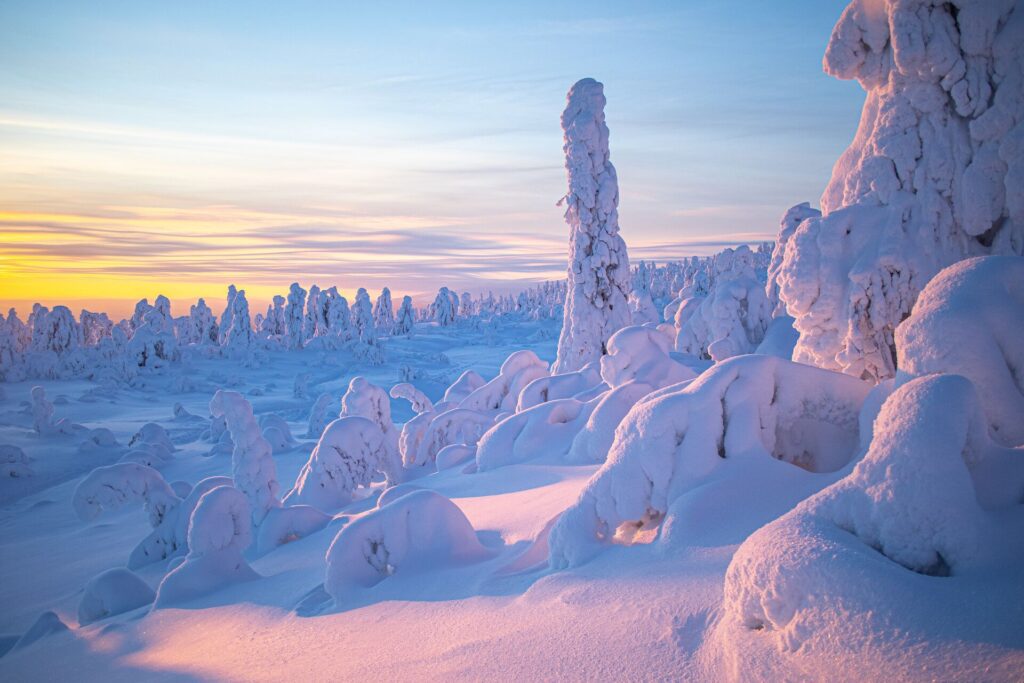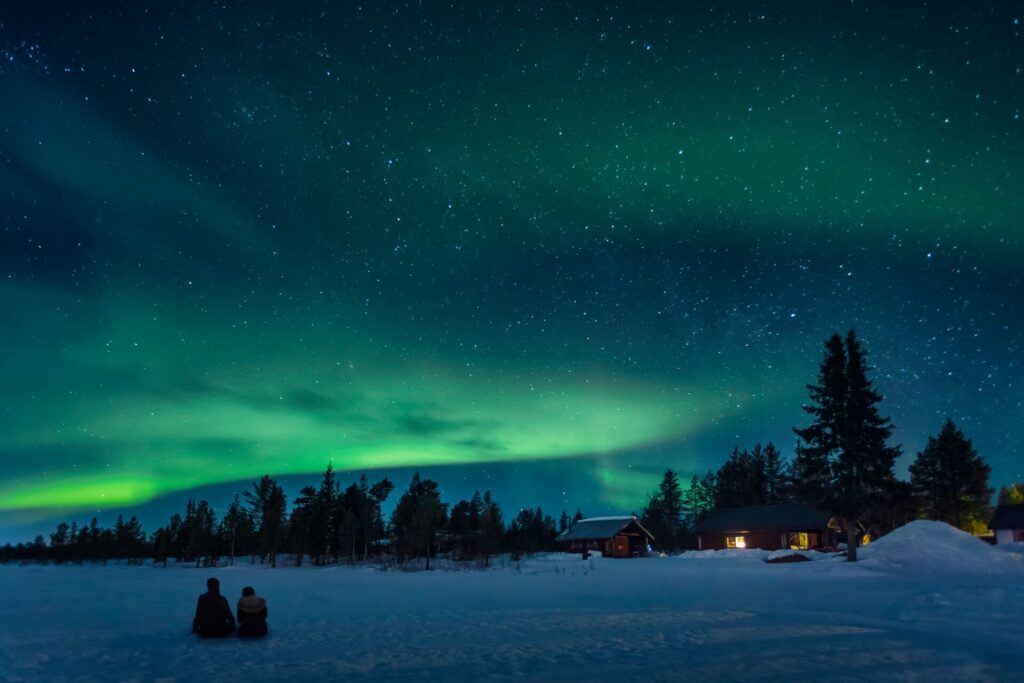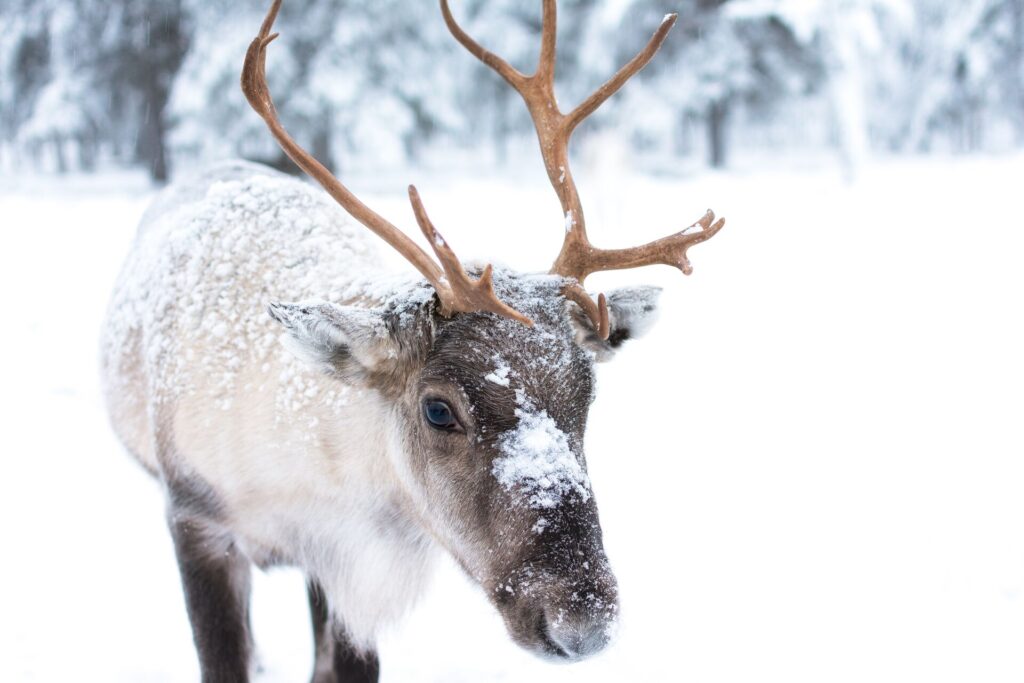Snow-cloaked forests, fairytale cabins, friendly reindeer, frozen lakes, and the Northern Lights dancing in the dark… Lapland is a world of superlative beauty, and extreme weather conditions. Here, everything you’ll need to stay warm and comfortable while enjoying every outdoor adventure under the pale winter sun.
Table of Contents


Dressing for the Arctic Climate
Winter in Lapland brings extreme cold, with temperatures often plunging as low as -30°C, there’s only a few hours of daylight each day and up to 200cm of snowfall. And while you’ll need to be ready for both mild and severe conditions, as any hardy outdoor adventurer will tell you, “There’s no such thing as bad weather, there’s only bad clothing.”
In Lapland, “good clothing” means clever layering. The principle is simple: layers provide insulation to retain body heat while evaporating sweat. In regions of extreme cold, losing body heat, or getting very sweaty, both put you at risk of hypothermia and frostbite. So, by creating layers of quality moisture-wicking fabric, you can regulate your body temperature simply by adding or removing pieces as conditions change.
Essential Clothing for Lapland Adventures
Think of layering as your cold-weather-comfort trifecta as it not only keeps you warm, dry and adaptable, it consists of three levels:
- Moisture-Wicking Base Layer
The thermal foundation pulls sweat away from your skin to prevent dampness. Fabrics like merino wool and synthetic materials like polyester or nylon are ideal due to their breathability, lightness, and moisture-wicking properties, while cotton should be avoided as it traps moisture.
To ace your base, pair full length leggings with a long-sleeve, fitted top; it’s important that these thermals fit close to the skin, so the warmth stays in. Kiwi brand Icebreaker’s range of 100 per cent merino undergarments for men, women and kids is moisture-wicking, non-itchy, lightweight and naturally odour-resistant, while Finnish brand North Outdoor’s merino gear has been designed and fabricated to suit Lapland’s varying conditions. Patagonia’s Capilene Thermal Weight collection of base layer essentials is Fair Trade certified and made from Polartec Power Grid fabric for exceptional warmth, breathability and moisture-wicking performance. And while heavy duty merino socks may be enough on their own, for added warmth you may also add a thermal sock liner, like Macpac’s Thermolite range. - Insulating Mid Layer
This thicker layer traps warmth close to your body with materials like fleece, high-quality ethical down and synthetic insulators. Fleece or merino trousers add an extra layer of insulation between your base and shell pants. For your core, wool jumpers and fleece pullovers are breathable and thermal, and work well beneath a puffer filled with ethical or synthetic down. Cotopaxi’s chic and cheerful range of Teca fleece pullovers are made from best-in-class, recycled fleece and repurposed polyester taffeta that would otherwise end up in the landfill, while their Fuego down jackets are equally ethical and sustainable, with each piece directly supporting the Certified B Corp’s Gear For Good Arcteryx, The North Face, and Marmot also offer excellent technical fleece and down options, while for classic Finnish knits, Ekta Helskini and Tuoriniemi are standouts. - Protective Outer Layer
This is your shell against the elements. It needs to be waterproof, windproof and breathable, so it’ll keep you dry and shielded from the cold while allowing sweat to escape. For this purpose Gore-Tex is ideal, although many reputable outdoor brands have their own technical waterproof, breathable shell fabrics for polar-rated outdoor pants, salopettes, snow-proof trousers, parkas and jackets, such as Patagonia’s H2No, the North Face’s Futurelight, Helly Hansen’s Helly Tech, and NanoPro Eco from Marmot. Many specialised brands also have 3-in-1 parkas and jackets – these usually consist of a down jacket zipped to the inside of a waterproof shell, giving you the option to wear one, the other, or both together. It’s also essential to choose the right boots for Arctic conditions – look for sturdy, well insulated high tops. We recommend those with removeable thermal inners for quick drying (such as a shearling liner); a waterproof outer layer, and a quality, heavy duty grippy sole that offers excellent traction for slippery conditions. Canadian brand Sorel’s Caribou range will fit the bill nicely, as will local Nordic brands Lundhags and Kuoma.
Northern lights photography workshops, snowmobile adventures and stays in aurora cabins are just a few highlights of this Finnish Lapland experience – Click here to discover the best of lapland.


Clever Accessories and Finishing Touches
Accessories are crucial to the layering process as they close up any gaps and shield the extremities. A good-quality hat or beanie will prevent heat loss from your head – choose one made from wool, preferably with fleece lining for bonus wind protection. For added warmth, you might opt for one with inbuilt ear flaps, or add a pair of earmuffs.
Scarves and Buff polar-fleece neck gaiters add another layer of protection and can also be pulled up over the nose when extra warmth is needed. Polarised sunglasses will protect your eyes against snow glare – Maui Jim, Oakley and Bolle all make stellar options. For hands, layer up by wearing merino gloves beneath a pair or waterproof mittens, or Vallerret and Sealskinz make camera-friendly winter-rated gloves for photographers. Bonus tip: it’s always worth carrying an extra pair of gloves, mid-layer pieces and a beanie in your daypack, in case you misplace yours or they become wet as you’re exploring.
Additional Items You’ll Need
For excursions, bring a weatherproof daypack – Fjallraven has Scandi-style options, while Cotopaxi’s standout adventure-ready backpacks are made from recycled fabrics. Bring a reusable water bottle, lip balm, hand cream, facial moisturiser, and sunscreen, as the cold and wind can be dehydrating. Rechargeable hand warmers, like these from Lifesystems, will keep your fingers frost-free. For photography, carry a spare memory card and battery (cold reduces battery life, so carry them in an internal pocket close to your body), and a lightweight tripod for aurora shots. For spotting wildlife, bring lightweight fog-free binoculars, like Nocs Provisions. A headtorch or flashlight, such as Ledlenser, will be useful for night activities. And don’t forget your swimwear – Lapland’s saunas are a highlight not to be missed.
Experts say the Northern Lights are about to become more active than usual, so 2025-26 is a great time to see them in Lapland. Click here to learn why and how.
What You Won’t Need to Pack
When you’re booking your Adventure World holiday (or if you’re independently liaising with local operators), it’s worth asking what gear is included (or rentable) before you travel so you can pack for any gaps. Some operators may include, boots, wool socks, and weatherproof outer layers, so you may not need to bring any of these items (but it is important to double check beforehand). If you’re worried about sizing (especially if you’re travelling with young children), it may be worth bringing your own anyway.


Packing List for Lapland
While this list isn’t exhaustive (and your tour operator may have additional suggestions), it covers the basics to get you started:
- Thermal base layer top
- Fleece or wool pullover
- Down or insulated jacket
- Waterproof jacket
- Thermal base layer pants
- Fleece trousers
- Waterproof ski pants or salopettes
- Heavy merino or Smartwool socks
- Gloves and/or mittens
- Scarf or neck gaiter
- Beanie or woollen hat
- Insulated, Arctic-rated boots
- Swimwear
- Small daypack
- Polarised sunglasses
- Camera, memory cards, spare battery and tripod
- Rechargeable hand warmers
- Headtorch or flashlight
- Binoculars
- Reusable water bottle
- Hand cream, facial moisturiser, lip balm and sunscreen


4 Common Lapland Packing Questions, Answered
Should I bring spare clothes?
Bring a backup pair of thermals so you can wash one set while wearing another. Extra gloves and a beanie will also come in handy if your originals end up wet, while a second pullover will provide extra insulation should conditions turn and you need another layer. As outer layers are designed to be waterproof, you should only need one set.
What should I look for when buying outdoor gear for Lapland?
While large retail chains may offer fashionable, affordable gear (like puffer jackets) suited to Australian winters, these are no match for the Arctic. Technical polar outdoor garments are more expensive, but are an investment in your safety. So, choose specialised retailers who can offer expert advice and polar-ready gear; Mont, Wild Earth, Larry Adler, and Paddy Pallin are Aussie standouts.
Can I buy gear in Lapland?
Yes. Buying local means the gear’s already been tried and tested in Lapland. In saying that, depending on where you visit there may be limited options for shopping, so do your research beforehand. Look out for Nordic brands like Halti, Helly Hansen, Haglöfs, Klättermusen and 66°North.
Should I bring my own boots?
If your Lapland tour operator doesn’t supply them, or you’re unsure about sizing, yes. The added benefit of BYO is that you can break them in before your trip. If you’re worried about how heavy they’ll be in your luggage, wear them on your flights (remove the thermal liners if you think you’ll be too toasty in transit).
